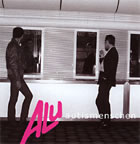 Johannes Vester and Ludwig Papenburg, along with with Ludwig's brotherUlrich, formed the group Sand, whose sole album (1974's Golem) is aKrautrock classic, famous for its haunting sparseness as well as the"Artifical Head" stereo mixing method pioneered by producer KlausSchulze.
Johannes Vester and Ludwig Papenburg, along with with Ludwig's brotherUlrich, formed the group Sand, whose sole album (1974's Golem) is aKrautrock classic, famous for its haunting sparseness as well as the"Artifical Head" stereo mixing method pioneered by producer KlausSchulze.
The album was not successful, and though today amint-condition original pressing can run into the thousands of dollarsat auction, at the time its failure meant that there would be no secondalbum for Sand, and the group disbanded. Johannes and Ludwig remainedfriends, however, and in 1980, they formed the cold-wave electro groupAlu, who in their four-year lifespan released a single, a pair of LPsand a few cassettes. Autismenschen represents an additionalalbum that was recorded in 1981 but was never released until now. I'vestruggled to find the right words to describe Alu, as I have very mixedfeelings about the project. I am a great fan of Vester and Papenburg'swork as Sand, which I first discovered (as I suspect many others did)when it was expanded and reissued on CD by Steven Stapleton and DavidTibet, who released the handsomely packaged Ultrasonic Seraphimon their United Durtro label in 1996. It should be noted that asidefrom some very labored comparisons that David Tibet attempts to drawbetween Sand and Alu in his liner notes for Autismenschen,there is absolutely no similarity between these two projects. Sand'sGolem is spacious and surreal, a visionary folk album which carved outa unique hallucinatory space that has never been repeated before orsince. Alu is very typical of the cold-wave electro sound, typified bymetronomic rhythms, jagged synths, chugging sequencers and barkedvocals awash with paranoia, claustrophobia and technological angst.It's not that Alu are in any way incompetent, but whereas their work asSand was notable for its uniqueness in the Krautrock canon, the work ofAlu is all but indistinguishable from its German new-wave and post-punkcontemporaries. The whole project reeks of a very deliberate bandwagonjump, as evidenced by comparing band photos in the booklet for the Sandand Alu reissues. When they were in Sand, Vester and Papenburg sportedbeards and long hair, and photographed themselves looking wide-eyed andbeatific, heads full of hash and acid, on park benches and inplaygrounds. When they made the transition to Alu, suddenly the beardsand manes were gone, and instead they are photographed in the typicalTuxedomoon uniform of suit and black tie, surrounded by banks ofelectronic gadgets, making tense, worried facial expressions. The lookseems contrived, and so does the music, unfortunately. This is not tosay that there is not much about Alu that will please those who adorethis period of music, but there is nothing about Alu specifically thattakes the music beyond the level of a mildly interesting footnote inthe history of this period. The overlapping chirps, squelches andstaccato rhythms do create a fair amount of intrigue on a track like"Sie Kriegt Alles Was Sie Will," but I can't help but feel but feelthat Alu represents a rather cynical attempt by two talented musiciansto appeal to a younger generation, and it rubs me the wrong way. In thewords of James Murphy of LCD Soundsytem: "I hear you're buying asynthesizer and an arpeggiator and throwing your computer out thewindow because you want to make something real/I hear that you and yourband have sold your guitars and bought turntables/I hear that you andyour band have sold your turntables and bought guitars."
samples:
Read More

